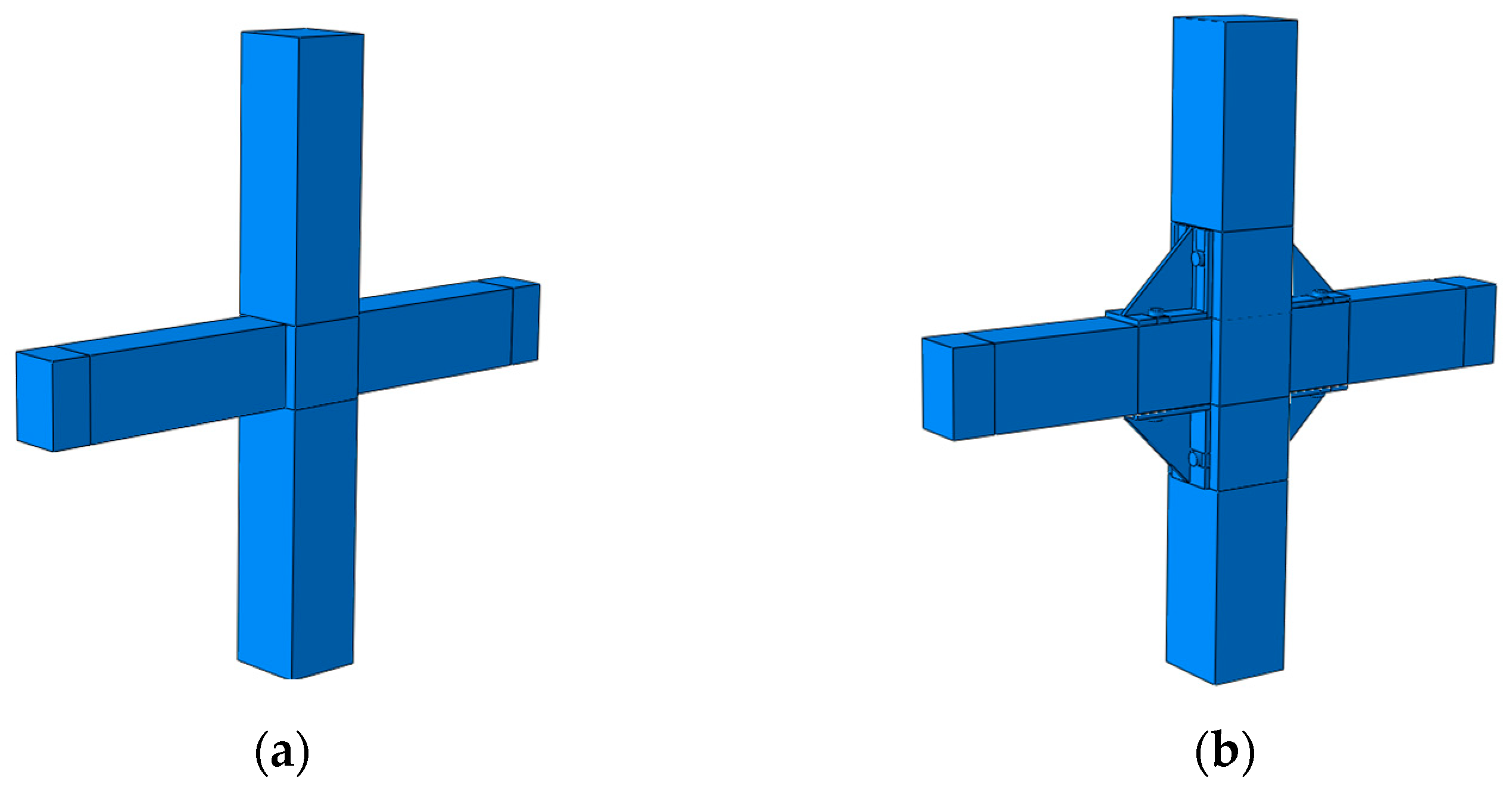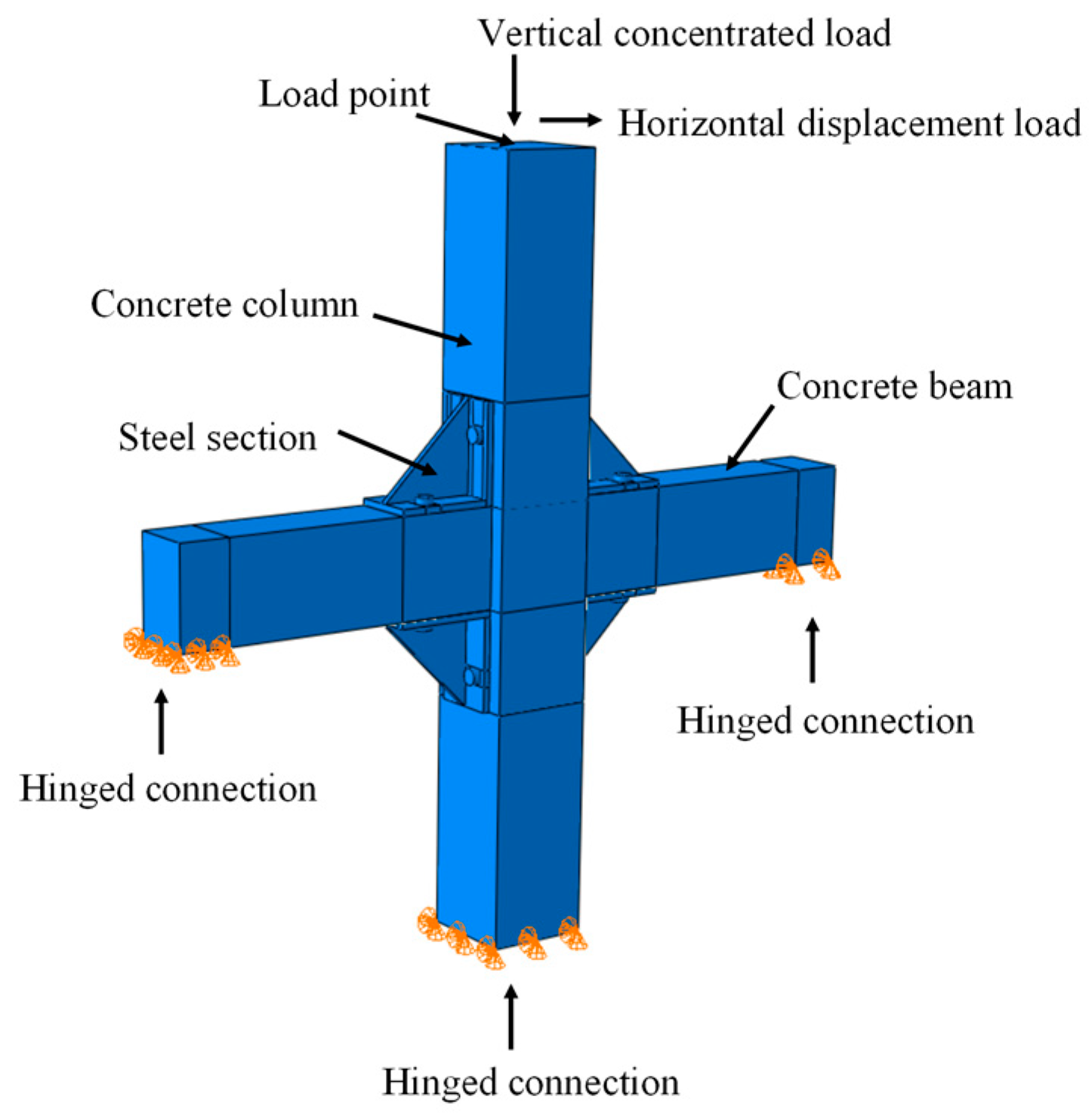Finite Element Analysis of Prefabricated Semi-Rigid Concrete Beam–Column Joint with Steel Connections
Abstract
1. Introduction
2. Establishment of the Finite Element Model
2.1. Geometric Models
2.2. Material Constitutive Relations
2.3. Boundary Conditions and Loading Method
3. Analysis of Finite Element Simulation Results
3.1. Hysteresis Curve and Skeleton Curve
3.2. Ductility Analysis of Joints
3.3. Comparison of Energy Consumption Capacities of Joints
4. Comparative Analysis of Force Mechanism
4.1. Concrete Stress Nephograms
4.2. Reinforcing Steel Stress Nephogram
4.3. Joint Damage Nephograms
5. Analysis of Factors Influencing Node Ductility and Energy Consumption
5.1. Axial Pressure Ratio
5.2. Concrete Strength
5.3. Reinforcing Steel Strength
5.4. Steel Section and Bolt Strengths
6. Conclusions
- (1)
- Compared with traditional joints, the ductility and the energy-consuming performance of the new joint were improved to a certain extent, and the ultimate bearing capacity was greatly improved. The seismic performance of the concrete beam–column joint connected using newly assembled steel sections proved to be superior to that of the traditional cast-in-place joint. This joint demonstrated excellent performance in seismic conditions, which meets the practical needs of modern precast concrete beam–column joint seismic performance analysis.
- (2)
- According to the nephogram analysis of the joints, it can be seen that the prefabricated joint had distinctive characteristics of concrete and reinforcing steel stress changes in the elastic stage, the ultimate bearing capacity stage, and the damage stage, and the damage mode was clear. Compared with the traditional cast-in-place joint, the performance indexes were superior, and the joint design was reasonable.
- (3)
- This study thoroughly examined and analyzed the influences of a variety of factors on the distinct properties of the new joint. This study observed that an increase in the axial compression ratio and the strength of the concrete had a positive impact on the ultimate load-carrying capacity and the energy dissipation capacity of the joint but led to a decrease in ductility. Therefore, it is crucial to reasonably set the axial compression ratio and concrete strength to ensure the ductility of joints in practical projects. Then, as the strength of the steel reinforcement in the joint increased, the ultimate load-carrying capacity and ductility also improved, while the energy dissipation capacity initially increased and then decreased. Therefore, an excessively high steel reinforcement strength may not necessarily be advantageous in enhancing the seismic capacity of joints. Furthermore, since the strength of steel section connectors is significantly higher than that of concrete, the use of high-strength components for steel section connectors does not produce a substantial improvement in seismic performance.
Author Contributions
Funding
Institutional Review Board Statement
Informed Consent Statement
Data Availability Statement
Conflicts of Interest
References
- Huang, Y.; Yi, W.J.; Clay, J.N.; Zhang, R. Seismic performance of precast concrete frames with debonded reinforcement. Mater. Struct. 2018, 51, 1–12. [Google Scholar]
- Jiang, L.; Li, Z.; Li, L.; Gao, Y. Constraints on the promotion of prefabricated construction in China. Sustainability 2018, 10, 2516. [Google Scholar] [CrossRef]
- Song, Y.P.; Wang, J.; Fan, G.X.; Cheng, W.P. Experimental study of mechanical properties of prefabricated frame structure beam-column joint. J. Dalian Univ. Technol. 2014, 54, 438–444. [Google Scholar]
- Fang, C.; Izzuddin, B.A.; Elghazouli, A.Y.; Nethercot, D.A. Modeling of semi-rigid beam-to-column steel joints under extreme loading. Front. Struct. Civ. Eng. 2013, 7, 245–263. [Google Scholar] [CrossRef]
- Zhang, X.; Hao, J.; Duan, D.; Xu, S.; Zhang, S.; Yu, H. Experimental study on bolted and anchored beam-to-column joints of prefabricated concrete frames. Adv. Struct. Eng. 2020, 23, 374–387. [Google Scholar] [CrossRef]
- Luo, X.; Long, H.; Ou, Y.; Dong, S. Study on finite element model of the prefabricated reinforced concrete beam-column joints with grouted sleeves. Adv. Civ. Eng. 2021, 2021, 1–15. [Google Scholar] [CrossRef]
- GB/T 51231-2016; Technical Standard for Assembled Buildings with Oncrete Structure. China Architecture & Building Press: Beijing, China, 2017.
- Alvin, M. The effect of joints on the stability behaviour of steel frame beams. J. Constr. Steel Res. 2002, 58, 1375–1390. [Google Scholar]
- Shi, Q.; Yan, S.; Kong, L.; Bu, X.; Wang, X.; Sun, H. Seismic behavior of semi-rigid steel joints—Major axis T-stub and minor axis end-plate. J. Constr. Steel Res. 2019, 159, 476–492. [Google Scholar] [CrossRef]
- Wang, J.; Wang, J.; Wang, H. Seismic behavior of blind bolted CFST frames with semi-rigid connections. Structures 2017, 9, 91–104. [Google Scholar] [CrossRef]
- Guo, L.; Wang, J.; Zhang, M. Modelling and experiment of semi rigid joint between composite beam and square CFDST column. Steel Compos. Struct. 2020, 34, 803–818. [Google Scholar]
- Yu, J.B.; Guo, Z.X.; Guo, X. Seismic behavior of a new type prefabricated concrete frame beam-column connections. Adv. Eng. Sci. 2018, 3, 209–215. [Google Scholar]
- Braconi, A.; Bursi, O.S.; Fabbrocino, G.; Salvatore, W.; Tremblay, R. Seismic performance of a 3D full-scale high-ductility steel–concrete composite moment-resisting structure—Part I: Design and testing procedure. Earthq. Eng. Struct. Dyn. 2008, 37, 1609–1634. [Google Scholar] [CrossRef]
- Ghayeb, H.H.; Razak, H.A.; Sulong, N.R. Development and testing of hybrid precast concrete beam-to-column connections under cyclic loading. Constr. Build. Mater. 2017, 151, 258–278. [Google Scholar] [CrossRef]
- Nzabonimpa, J.D.; Hong, W.K.; Kim, J. Experimental and non-linear numerical investigation of the novel detachable mechanical joints with laminated plates for composite precast beam-column joint. Compos. Struct. 2018, 185, 286–303. [Google Scholar] [CrossRef]
- Choi, H.K.; Choi, Y.C.; Choi, C.S. Development and testing of precast concrete beam-to-column connection. Eng. Struct. 2013, 56, 1820–1835. [Google Scholar] [CrossRef]
- Lacerda, M.M.S.; da Silva, T.J.; Alva, G.M.S.; de Lima, M.C.V. Influence of the vertical grouting in the interface between corbel and beam in beam-to-column connections of precast concrete structures—An experimental analysis. Eng. Struct. 2018, 172, 201–213. [Google Scholar] [CrossRef]
- Zhao, B.; Lu, X.L.; Liu, H.F. Experimental study on seismic behavior of precast concrete beam-column subassemblage with cast-in-situ monolithic joint. J. Build. Struct. 2004, 6, 22–28. [Google Scholar]
- Li, Z.Y.; Huang, Y.Z.; Lu, W.; He, Q.H. Seismic behavior of semi-rigid joints of precast concrete beam and column. J. Civ. Environ. Eng. 2023, 45, 55–64. [Google Scholar]
- Pan, Z.; Si, Q.; Zhu, Y.; Ying, H.; Wang, X.; Du, D. Seismic performance of prefabricated semi-rigid RCS structures. Structures 2022, 43, 1369–1379. [Google Scholar] [CrossRef]
- Zhao, G.T.; Zhao, C.; Li, B.S.; Wang, L.Y. Experimental study and optimization analysis on PEC composite column-type steel beam frame semi-rigid joint seismic performance. Build. Struct. 2022, 52, 92–98. [Google Scholar]
- Ding, K.W.; Liu, J.H.; Ma, W.; Liu, Y.L. Experimental study on seismic performances of a new type of fabricated semi-rigid beam-to-column connection. China Civ. Eng. J. 2021, 54, 1–7+56. [Google Scholar]
- Yu, S.B.; Huang, S.J.; Gao, P. Finite Element Analysis of Mechanical Behavior of Beam Column Semi-RigioJoints in Precast Concrete Frame. In Proceedings of the 2022 Industrial Building Academic Exchange Conference, Beijing, China, 10 February 2022. [Google Scholar]
- Silva, A.R.; Batelo, E.A.; Silveira, R.A.; Neves, F.A.; Gonçalves, P.B. On the nonlinear transient analysis of planar steel frames with semi-rigid connections: From fundamentals to algorithms and numerical studies. Lat. Am. J. Solids Struct. 2018, 15, e28. [Google Scholar] [CrossRef]
- Baltay, P.; Gjelsvik, A. Coefficient of friction for steel on concrete at high normal stress. J. Mater. Civ. Eng. 1990, 2, 46–49. [Google Scholar] [CrossRef]
- Wang, Y.Z.; Fu, C.G. ABAQUS Structural Engineering Analysis and Examples, 1st ed.; China Architecture & Building Press: Beijing, China, 2010; pp. 102–186. [Google Scholar]
- GB 50010-2010; Code for Design of Concrete Structures. China Architecture & Building Press: Beijing, China, 2010.
- Li, G.C.; Wang, S.; Tian, L.; Bao, C.Y. FEM analisis on the performance of concrete bucking restrained brace joints. Eng. Mech. 2013, 30, 212–216. [Google Scholar]
- JGJ/T 101-2015; Specification for Seismic Test of Buildings. China Architecture & Building Press: Beijing, China, 2015.
- Wu, C.X.; Zhou, Y.; Lai, W.S.; Zhang, Y.F.; Deng, X.S. Experiment on seismic performance of castinsitu and prefabricated concrete frame structure joints. J. Archit. Civ. Eng. 2018, 32, 60–66. [Google Scholar]
- Liu, K.X.; Yu, Y.S.; Wei, L.; Wang, Y. Comparative analysis of three design methods for a new typebeam-column assembled rigid joint. World Earthq. Eng. 2017, 33, 84–90. [Google Scholar]
- Wang, Q.W.; Zhang, Y.K.; Zhang, H.Z. Finite element analysis on mechanical behavior of SRC spacial interior joints. J. Xi’an Univ. Archit. Technol. 2016, 48, 853–861. [Google Scholar]
- Wang, J.; Zhang, N. Performance of circular CFST column to steel beam joints with blind bolts. J. Constr. Steel Res. 2017, 130, 36–52. [Google Scholar] [CrossRef]
- Wang, J.; Li, B.; Li, J. Experimental and analytical investigation of semi-rigid CFST frames with external SCWPs. J. Constr. Steel Res. 2017, 128, 289–304. [Google Scholar] [CrossRef]











| Joint Form | Column (mm) | Beam (mm) | Steel Section (mm) | Bolt Diameter (mm) |
|---|---|---|---|---|
| Cast-in-place joint | 300 × 300 × 2300 | 300 × 200 × 2300 | \ | \ |
| Prefabricated joint | 300 × 300 × 2300 | 300 × 200 × 2300 | 300 × 300 × 20 | 30 |
| Joint Form | (mm) | (mm) | (kN) | (kN) | (kN) | |
|---|---|---|---|---|---|---|
| Cast-in-place joint | 1.53 | 10.36 | 6.77 | 76.13 | 83.86 | 107.62 |
| Prefabricated joint | 2.36 | 17.13 | 7.26 | 103.24 | 123.51 | 141.77 |
| Joint Form | Yield State | Limit State | Damage State |
|---|---|---|---|
| Cast-in-place joint | 0.37 | 0.58 | 1.53 |
| Prefabricated joint | 0.31 | 0.66 | 1.54 |
| Axial Pressure Ratio | Ultimate Bearing Capacity (kN) | Ductility | Energy Dissipation Coefficient |
|---|---|---|---|
| 0.2 | 130.04 | 16.67 | 0.603 |
| 0.3 | 134.50 | 12.07 | 0.616 |
| 0.4 | 141.04 | 8.57 | 0.625 |
| 0.5 | 144.59 | 5.98 | 0.609 |
| Concrete Strength | Ultimate Bearing Capacity (kN) | Ductility | Energy Dissipation Coefficient |
|---|---|---|---|
| C30 | 128.98 | 11.70 | 0.634 |
| C40 | 141.04 | 8.57 | 0.625 |
| C50 | 149.95 | 7.67 | 0.648 |
| C60 | 153.69 | 7.48 | 0.630 |
| Reinforcing Steel Strength | Ultimate Bearing Capacity (kN) | Ductility | Energy Dissipation Coefficient |
|---|---|---|---|
| HPB300 | 134.49 | 6.21 | 0.577 |
| HRB335 | 134.86 | 6.58 | 0.824 |
| HRB400 | 141.77 | 10.79 | 0.645 |
| HRB500 | 146.31 | 13.58 | 0.70 |
Disclaimer/Publisher’s Note: The statements, opinions and data contained in all publications are solely those of the individual author(s) and contributor(s) and not of MDPI and/or the editor(s). MDPI and/or the editor(s) disclaim responsibility for any injury to people or property resulting from any ideas, methods, instructions or products referred to in the content. |
© 2024 by the authors. Licensee MDPI, Basel, Switzerland. This article is an open access article distributed under the terms and conditions of the Creative Commons Attribution (CC BY) license (https://creativecommons.org/licenses/by/4.0/).
Share and Cite
Xiao, Y.; Yu, M.; Liu, W. Finite Element Analysis of Prefabricated Semi-Rigid Concrete Beam–Column Joint with Steel Connections. Appl. Sci. 2024, 14, 5070. https://doi.org/10.3390/app14125070
Xiao Y, Yu M, Liu W. Finite Element Analysis of Prefabricated Semi-Rigid Concrete Beam–Column Joint with Steel Connections. Applied Sciences. 2024; 14(12):5070. https://doi.org/10.3390/app14125070
Chicago/Turabian StyleXiao, Yong, Min Yu, and Wei Liu. 2024. "Finite Element Analysis of Prefabricated Semi-Rigid Concrete Beam–Column Joint with Steel Connections" Applied Sciences 14, no. 12: 5070. https://doi.org/10.3390/app14125070
APA StyleXiao, Y., Yu, M., & Liu, W. (2024). Finite Element Analysis of Prefabricated Semi-Rigid Concrete Beam–Column Joint with Steel Connections. Applied Sciences, 14(12), 5070. https://doi.org/10.3390/app14125070






